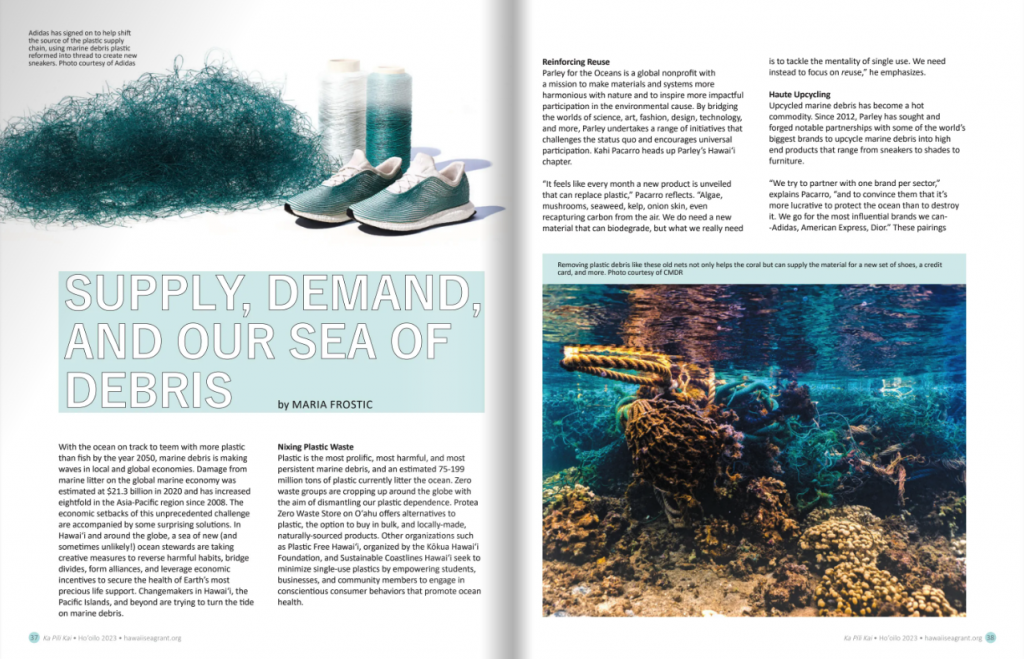With the ocean on track to teem with more plastic than fish by the year 2050, marine debris is making waves in local and global economies. Damage from marine litter on the global marine economy was estimated at $21.3 billion in 2020 and has increased eightfold in the Asia-Pacific region since 2008. The economic setbacks of this unprecedented challenge are accompanied by some surprising solutions. In Hawaiʻi and around the globe, a sea of new (and sometimes unlikely!) ocean stewards are taking creative measures to reverse harmful habits, bridge divides, form alliances, and leverage economic incentives to secure the health of Earth’s most precious life support. Changemakers in Hawai‘i, the Pacific Islands, and beyond are trying to turn the tide on marine debris.
Nixing Plastic Waste
Plastic is the most prolific, most harmful, and most persistent marine debris, and an estimated 75-199 million tons of plastic currently litter the ocean. Zero waste groups are cropping up around the globe with the aim of dismantling our plastic dependence. Protea Zero Waste Store on Oʻahu offers alternatives to plastic, the option to buy in bulk, and locally-made, naturally-sourced products. Other organizations such as Plastic Free Hawaiʻi, organized by the Kōkua Hawaiʻi Foundation, and Sustainable Coastlines Hawaiʻi seek to minimize single-use plastics by empowering students, businesses, and community members to engage in conscientious consumer behaviors that promote ocean health.
Reinforcing Reuse
Parley for the Oceans is a global nonprofit with a mission to make materials and systems more harmonious with nature and to inspire more impactful participation in the environmental cause. By bridging the worlds of science, art, fashion, design, technology, and more, Parley undertakes a range of initiatives that challenges the status quo and encourages universal participation. Kahi Pacarro heads up Parley’s Hawaiʻi chapter.
“It feels like every month a new product is unveiled that can replace plastic,” Pacarro reflects. “Algae, mushrooms, seaweed, kelp, onion skin, even recapturing carbon from the air. We do need a new material that can biodegrade, but what we really need is to tackle the mentality of single use. We need instead to focus on reuse,” he emphasizes.
Haute Upcycling
Upcycled marine debris has become a hot commodity. Since 2012, Parley has sought and forged notable partnerships with some of the world’s biggest brands to upcycle marine debris into high end products that range from sneakers to shades to furniture.
“We try to partner with one brand per sector,” explains Pacarro, “and to convince them that it’s more lucrative to protect the ocean than to destroy it. We go for the most influential brands we can -Adidas, American Express, Dior.” These pairings are a win-win for big brands as well as the ocean. “Partnering with us reduces their need to spend money on marketing,” notes Pacarro. “The brand’s efforts go viral for the right reasons, and both sides of the transaction can view themselves as a part of the solution.”
Leveraging Likes
The Ocean Cleanup is another global nonprofit making powerful alliances as part of its mission to develop and scale technologies to clean up 90 percent of the world’s floating plastic. The concept was initially dreamed up by Dutch entrepreneur and inventor Boyan Slat, who at age 16 saw plastic bag after plastic bag while diving in Greece and was compelled to make cleaning up the ocean his life’s work. The Ocean Cleanup made a big splash in 2021- 2022 when it aligned with the Ocean Conservancy to enlist YouTube superstars MrBeast and Mark Rober in #TeamSeas, a fundraising effort that tapped this dynamic duo’s significant sphere of influence and pulled in $30 million to remove 30M pounds of marine debris.
“Our mission is one of global proportion. Therefore, it’s crucial that we amplify our message,” shares CEO Slat of the effort.
Researching Rubbish
The Center for Marine Debris Research launched in 2019 as a joint effort between Hawaiʻi Pacific University and the National Institute of Standards and Technology to investigate the many facets of marine debris and promote better ocean stewardship. Dr. Brenda Jensen, Dean of the College of Natural Sciences at Hawai’i Pacific University, is heartened by the strides the team is making, and said “For a long time, the issue seemed too big to tackle. But we are starting to intelligently break down the problem, describe it, and have the vocabulary to fix it.”
Engaging Everyone
We are navigating new waters in the Anthropocene era; the way forward is complex, and the stakes feel impossibly high. To tackle this sea of debris, we truly need everyone to take a cue from the players profiled here.
“Companies must be driven to change, and consumers must be driven to change,” emphasizes Pacarro. “We need new products that put the ocean before the bottom line.”
A full spectrum of committed participants, from revolutionary researchers and pioneering thinkers to a fleet of consumers, businesses, and policymakers must be ready and willing to end outdated, wasteful habits and embrace new approaches that put the ocean first.
Browse Ka Pili Kai issues HERE


